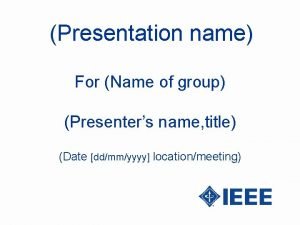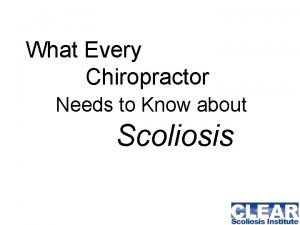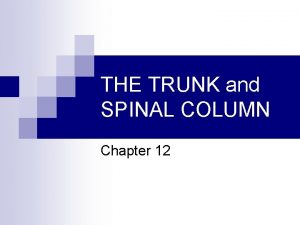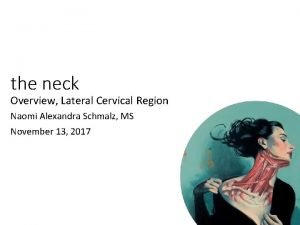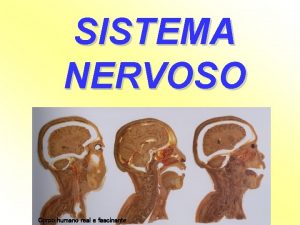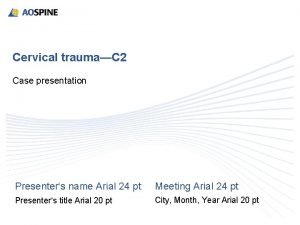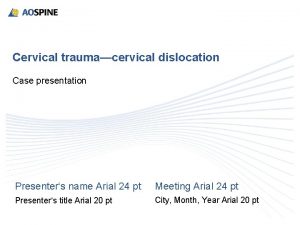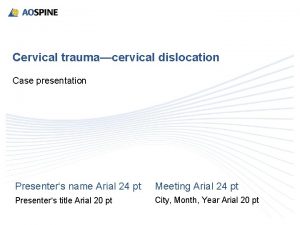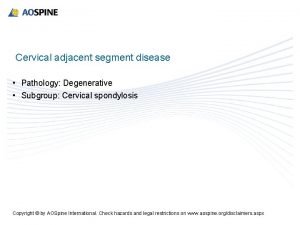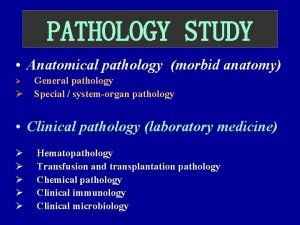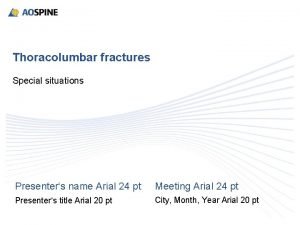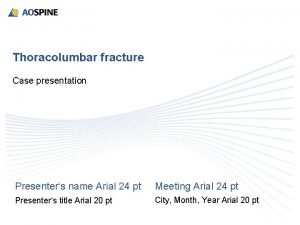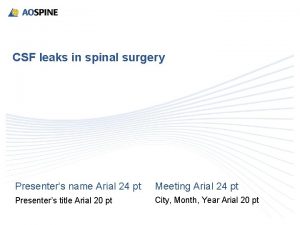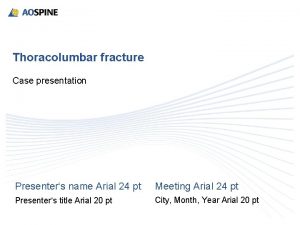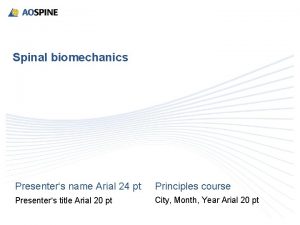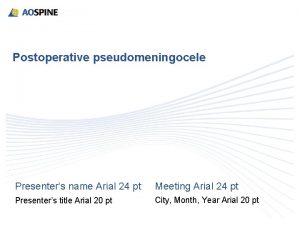Radiological evaluation of cervical pathology Presenters name Arial

























- Slides: 25

Radiological evaluation of cervical pathology Presenter‘s name Arial 24 pt Meeting Arial 24 pt Presenter‘s title Arial 20 pt City, Month, Year Arial 20 pt

Learning outcomes • Use and interpret appropriate diagnostic tools to assess cervical degenerative disease • Outline the role and indications for the use of other diagnostic tools, such as EMG and injections • Correlate investigation findings with clinical features

Incidence • Plain x-rays for patients with pain that persists for more than 10– 14 days

• 54 -year-old male • Neck and arm pain suggestive of C 6 nerve root irritation

• 32 -year-old male • Sudden onset of right arm pain and numbness extending into the right thumb and index finger

Diffuse degenerative change Focal degenerative change

Radiological investigation • Plain x-rays for patients with pain that persists for more than 10– 14 days • Flexion and extension x-rays used to assess instability

15 -year-old female, involved in competitive volleyball, had cervical x-rays for neck pain

C 1/2 instability secondary to os odontoidium

Radiological investigation • Plain x-rays for patients with pain that persists for more than 10– 14 days • Flexion and extension x-rays used to assess instability • MRI has largely replaced CT and myelography in the evaluation of cervical pathology

• 54 -year-old male • Neck and arm pain suggestive of C 6 nerve root irritation

• 54 -year-old male • Neck and arm pain suggestive of C 6 nerve root irritation

• 32 -year-old male • Sudden onset of right arm pain and numbness extending into the right thumb and index finger

• 32 -year-old male • Sudden onset of right arm pain and numbness extending into the right thumb and index finger

Radiological investigation • Plain x-rays for patients with pain that persists for more than 10– 14 days • Flexion and extension x-rays used to assess instability • MRI has largely replaced CT in the evaluation of cervical pathology • CT useful for bony pathology, trauma, assessment of calcified discs, OPLL, etc

• 47 -year-old female presented with: – Clumsiness of both hands – Spastic gait – Urinary and rectal dysfunction • Plain x-rays indicate spondylosis

• 47 -year-old female presented with: – Clumsiness of both hands – Spastic gait – Urinary and rectal dysfunction • Plain x-rays indicate spondylosis • MRI reveals significant anterior canal and cord compromise but fails to differentiate bone from disc

• 47 -year-old female presented with: – Clumsiness of both hands – Spastic gait – Urinary and rectal dysfunction • Plain x-rays indicate spondylosis • MRI reveals significant anterior canal and cord compromise but fails to differentiate bone from disc • CT reveals multilevel OPLL and extent of bony canal stenosis

Radiological investigation • Plain x-rays for patients with pain that persists for more than 10– 14 days • Flexion and extension x-rays used to assess instability • MRI has largely replaced CT in the evaluation of cervical pathology • CT useful for bony pathology, trauma, assessment of calcified discs, OPLL, etc • Myelography still indicated for selected cases

Difficult to assess foraminal capacity in cervical spine on MRI

Amputation of C 7 root CT myelography clearly shows nerve root compression in the foramen

MRI myelography also available and provides similar resolution to CT myelography

Radiological investigation • EMG may be used to confirm presence of neural compromise and to localize origin of neurological compromise or deficit: • Central or peripheral • At what level

Take-home messages • Plain x-rays are useful to assess alignment, instability, and spondylosis • MRI is the investigation of choice in the assessment of cord or neural compromise • CT is still useful for assessing bony canal compromise, and the assessment of bony union in patients having undergone spinal fusion procedures • Myelography, traditional or MRI myelography, is useful to localize neural compromise in patients with multilevel degeneration

Excellence in Spine
 Rgb presenters
Rgb presenters Presenter name
Presenter name Nama group presentation
Nama group presentation Job title example
Job title example Name/title of presenter
Name/title of presenter Center for devices and radiological health
Center for devices and radiological health National radiological emergency preparedness conference
National radiological emergency preparedness conference Radiological dispersal device
Radiological dispersal device Tennessee division of radiological health
Tennessee division of radiological health Atv presenters
Atv presenters Michael henderson monash
Michael henderson monash Thank you to all presenters
Thank you to all presenters Calender presenters
Calender presenters Famous british tv presenters
Famous british tv presenters Name all the lines name all the segments name all the rays
Name all the lines name all the segments name all the rays Scoliometer
Scoliometer Cervical ectropion
Cervical ectropion False vertebrae
False vertebrae Nuchal line muscle attachment
Nuchal line muscle attachment Muscular process of arytenoid cartilage
Muscular process of arytenoid cartilage Spinal nerves
Spinal nerves Olivas bulbares
Olivas bulbares Cervical fascia
Cervical fascia Cervical circulage
Cervical circulage Posterior scalene muscle
Posterior scalene muscle Subclavian artery
Subclavian artery


